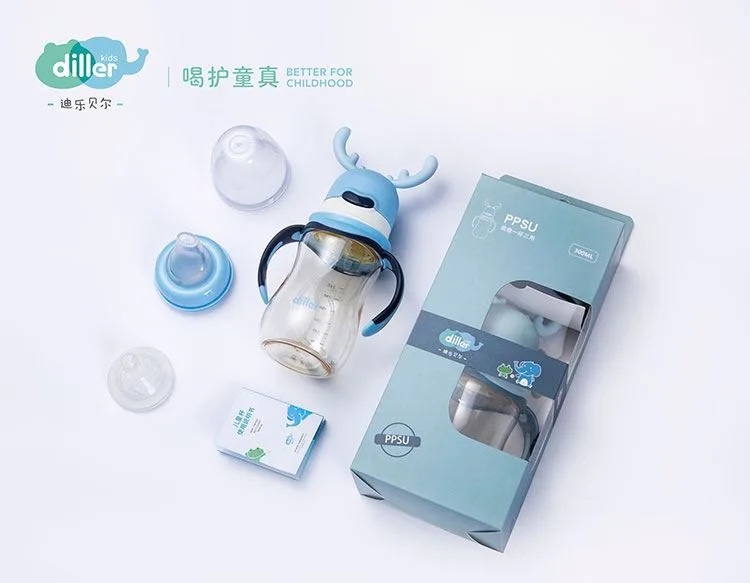Introducción de métodos de esterilización de biberones para bebés.
Desinfección por ebullición.
1. Prepare una cacerola de acero inoxidable llena de agua fría a una profundidad que cubra completamente todos los utensilios de alimentación limpios. (La cacerola de acero inoxidable debe esterilizarse solo para biberones de bebés y no se puede mezclar con otros alimentos para cocinar en casa)
2. Si el biberón es de vidrio, se puede colocar en la olla junto con agua fría. Después de que el agua hierva durante 5 a 10 minutos, coloque la tetina, la tapa del biberón y otros productos de plástico. Cubra la olla con la tapa y cocine durante 3 a 5 minutos, luego apague el fuego. Cuando el agua esté un poco fría, saque la tetina y la tapa del biberón con la pinza esterilizada y vuelva a colocarla en el biberón después de que esté seco. Si es un biberón de plástico para bebés, debe esperar a que hierva el agua y luego colocar el biberón, la tetina y la tapa del biberón en la olla para desinfectarlos y hervirlos durante aproximadamente 3 a 5 minutos. Finalmente, saque todas las piezas con la pinza esterilizada y colóquelas en un lugar limpio y ventilado, luego abroche y escurra.
3. Cabe señalar que el biberón de plástico para bebés no debe hervirse durante mucho tiempo, por lo que se recomienda colocarlo en el biberón después de hervirlo durante 3 a 5 minutos, de lo contrario, es fácil que se deteriore. También puede prestar atención a la etiqueta de temperatura en el biberón. Si no es resistente al calor, es mejor usar una olla de vapor para desinfectarlo.
Desinfección de ollas a vapor.
Existen en el mercado muchos tipos de ollas a vapor eléctricas con distintas funciones y marcas. Los padres pueden elegir según sus propias necesidades. El método de desinfección solo necesita seguir las instrucciones, para lograr el propósito de desinfectar los aparatos de alimentación. Sin embargo, se debe tener en cuenta que antes de usar la olla a vapor para la desinfección, todos los biberones, tetinas, tapas de biberones y otros elementos deben limpiarse a fondo y luego colocarse juntos. Presione el interruptor. Una vez completada la desinfección, el suministro de energía se cortará automáticamente.
Después de desinfectar el biberón, se debe vaciar completamente el agua residual del biberón y, a continuación, se debe invertir el biberón y vaciarlo. El biberón, la tetina y la tapa del biberón esterilizados se deben sacar con pinzas esterilizadas y colocar en un lugar ventilado y limpio para su uso en espera, y se deben cubrir con una gasa o una funda. Además, si el biberón sigue sin utilizarse tras 24 horas de desinfección, es necesario volver a realizar la desinfección para evitar la reproducción de bacterias. Después de cada toma de leche del bebé, la madre puede utilizar primero el cepillo para biberones para limpiar el biberón, recogerlo y ponerlo en el portabiberones para que se seque. Después de acumular una cierta cantidad o el tamaño que pueda contener el recipiente de desinfección, la madre puede realizar la tarea de desinfección en conjunto. Por tanto, la madre debe preparar muchos biberones a la vez para satisfacer las necesidades del bebé.
Método de inmersión en desinfectante químico.
Remojar en solución de ácido peracético 0,5% durante 30 minutos. O remojar en solución de permanganato de potasio 0,1% durante 30 minutos, o TD y otro desinfectante de cloro eficaz, poner 10 g en 1 kg durante 2-3 minutos, luego sacar y enjuagar con agua.
Desinfección por microondas.
Llene el biberón limpio con agua y colóquelo en el horno microondas. Encienda el aparato a temperatura alta durante 10 minutos. No coloque la tetina ni la tapa de conexión en el horno microondas para evitar que se deformen y se dañen.
Los padres pueden elegir un limpiador de biberones para limpiar el biberón del bebé, que es más rápido, más eficiente y más seguro.
Desinfección tradicional.
Hervir el biberón es un método de desinfección tradicional, su principio es hervir el agua a 100 ℃, coloque el biberón esterilizado en agua hirviendo y esterilice el biberón del bebé a alta temperatura.


